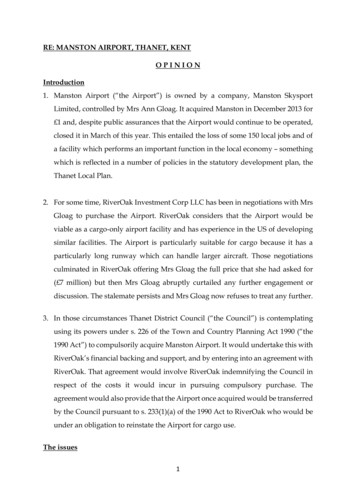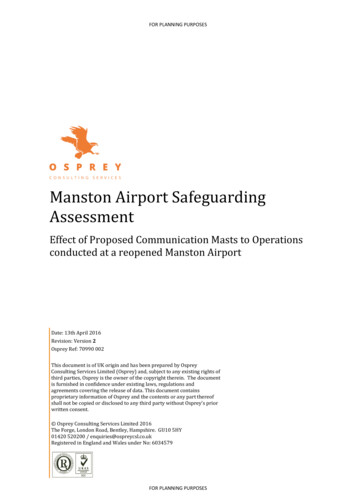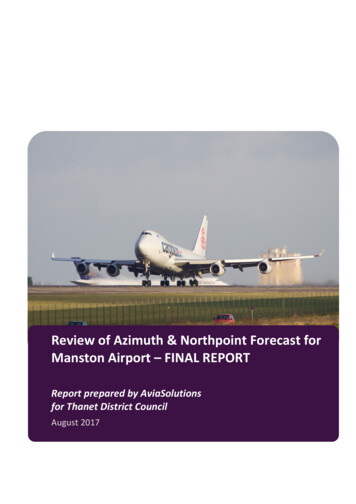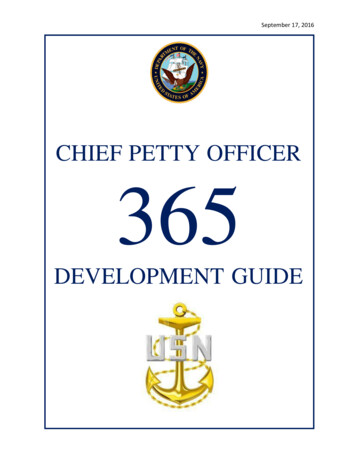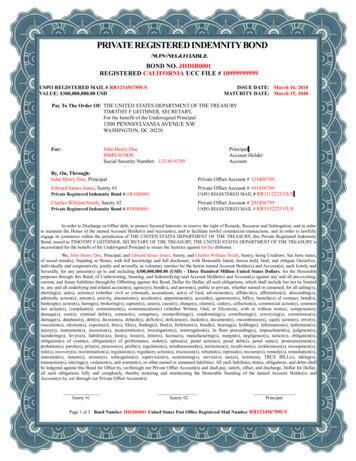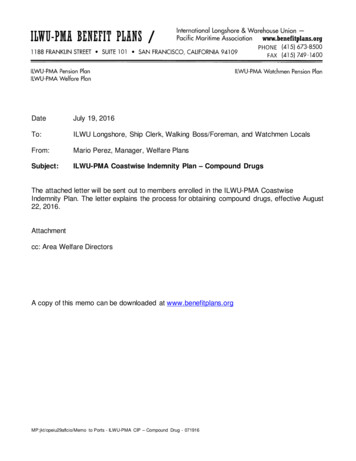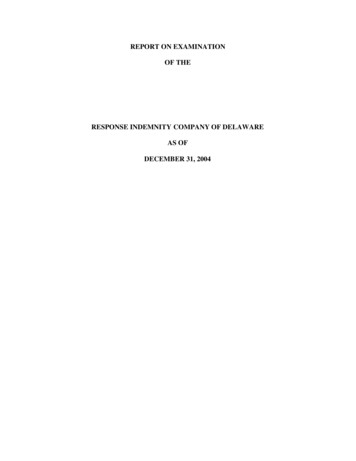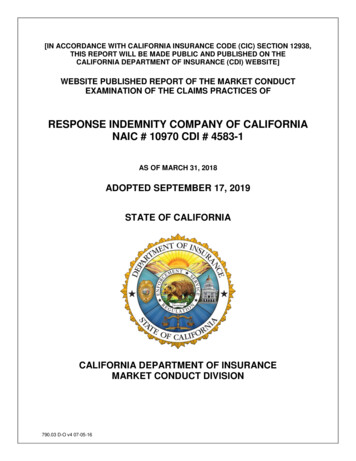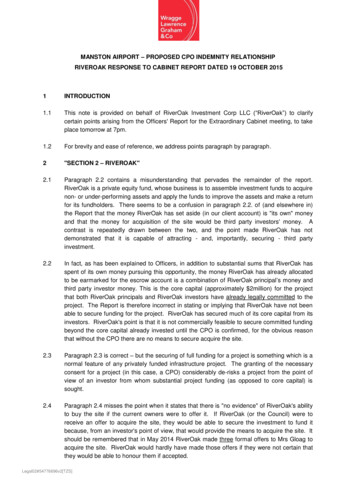
Transcription
MANSTON AIRPORT – PROPOSED CPO INDEMNITY RELATIONSHIPRIVEROAK RESPONSE TO CABINET REPORT DATED 19 OCTOBER 20151INTRODUCTION1.1This note is provided on behalf of RiverOak Investment Corp LLC (“RiverOak”) to clarifycertain points arising from the Officers' Report for the Extraordinary Cabinet meeting, to takeplace tomorrow at 7pm.1.2For brevity and ease of reference, we address points paragraph by paragraph.2"SECTION 2 – RIVEROAK"2.1Paragraph 2.2 contains a misunderstanding that pervades the remainder of the report.RiverOak is a private equity fund, whose business is to assemble investment funds to acquirenon- or under-performing assets and apply the funds to improve the assets and make a returnfor its fundholders. There seems to be a confusion in paragraph 2.2. of (and elsewhere in)the Report that the money RiverOak has set aside (in our client account) is "its own" moneyand that the money for acquisition of the site would be third party investors' money. Acontrast is repeatedly drawn between the two, and the point made RiverOak has notdemonstrated that it is capable of attracting - and, importantly, securing - third partyinvestment.2.2In fact, as has been explained to Officers, in addition to substantial sums that RiverOak hasspent of its own money pursuing this opportunity, the money RiverOak has already allocatedto be earmarked for the escrow account is a combination of RiverOak principal’s money andthird party investor money. This is the core capital (approximately 2million) for the projectthat both RiverOak principals and RiverOak investors have already legally committed to theproject. The Report is therefore incorrect in stating or implying that RiverOak have not beenable to secure funding for the project. RiverOak has secured much of its core capital from itsinvestors. RiverOak's point is that it is not commercially feasible to secure committed fundingbeyond the core capital already invested until the CPO is confirmed, for the obvious reasonthat without the CPO there are no means to secure acquire the site.2.3Paragraph 2.3 is correct – but the securing of full funding for a project is something which is anormal feature of any privately funded infrastructure project. The granting of the necessaryconsent for a project (in this case, a CPO) considerably de-risks a project from the point ofview of an investor from whom substantial project funding (as opposed to core capital) issought.2.4Paragraph 2.4 misses the point when it states that there is "no evidence" of RiverOak's abilityto buy the site if the current owners were to offer it. If RiverOak (or the Council) were toreceive an offer to acquire the site, they would be able to secure the investment to fund itbecause, from an investor's point of view, that would provide the means to acquire the site. Itshould be remembered that in May 2014 RiverOak made three formal offers to Mrs Gloag toacquire the site. RiverOak would hardly have made those offers if they were not certain thatthey would be able to honour them if accepted.Legal02#54776696v2[TZS]
3"SECTION 3 – TIMELINE"3.1Paragraph 3.2(b) of the Report refers to the "letter of credit". This issue is referred to timeand again throughout the Report, and is presented as if RiverOak extended an offer of a letterof credit which it later withdrew. Our understanding is that a meeting took place (at whichRiverOak's George Yerrall was not present) during which the term "letter of credit" was usedby a RiverOak representative, when in fact the provision of a letter of credit has never beenintended to be offered. This is regrettable, and it has proven to be a significant bone ofcontention. However, it was not long before RiverOak's proper position was clarified andexplained to the Council. RiverOak (and we on their behalf) have on several occasions soughtto clarify that a letter of credit cannot be provided at this stage, and to explain why it is notnecessary. However, it is misleading for the Report to present what was actually amiscommunication into an act of bad faith on RiverOak's part. It is not usual practice for togive a letter of credit at this point in the process, and it is not necessary.3.2Paragraph 3.3 refers to legal advice the Council has obtained. However, no reference ismade to the legal advice (in a letter dated 18 June 2015) given to the Council by KCC Legalwith is at odds with the analysis put forth in the Report.3.3Paragraph 3.4 and 3.6 refers to RiverOak having not given Officers an "up to date" businessplan. A business plan was submitted to the Council in December last year, as part of theoriginal submission. There has been no change in RiverOak's analysis of the businessproposition presented by Manston, and so they continue to stand by that. If appointed as theCouncil's indemnity partner, RiverOak would be able to appoint the consultant team andcommission the necessary work to produce a detailed business plan, in consultation with theCouncil.3.4Paragraph 3.5 refers to the letter of credit again and comments that the funding "revertedback" to its December 2014 position. This is misleading for the reason explained inparagraph 3.1 of this paper. The letter of credit was not intended to be offered. Paragraph3.8 – "in substitution for a letter of credit ". We refer again to paragraph 3.1.3.5In paragraph 3.9 it is stated that the letter that RiverOak provided from a US airportdeveloper/manager is of "little value" because it is not legally binding. We have alreadyexplained above why it is the case that a potential investor of significant project funding wouldonly enter into a binding commitment once the project consents were obtained. The CPOCircular requires "general funding intentions" to be demonstrated, not legally committedfunding, and so this paragraph of the Report is misleading.3.6Paragraph 3.14 is surprising. At a meeting on 4 September between RiverOak and theCouncil (and respective solicitors), the Council representatives were offered the opportunity toexamine unredacted copies of both investor letters. However, the Council Leader Mr Wellsdeclined the offer, stating that it was "not necessary". In any event, one of the investors inquestion was present at the meeting, indeed he led the negotiation for RiverOak. He also metMr Wells on a previous occasion in Thanet. The Council has therefore has significant directcontact with one of the investors. This is not mentioned in the Report and it is not clearwhether the Counsel who opined on the weight to be given to these letters was made awareof that.Legal02#54776696v2[TZS]
3.7Paragraph 3.17 – the bond. This has proven to be another bone of contention. There wasreference to a bond in the original draft CPO Indemnity Agreement, and that referenceremains in place. For some reason, Officers appeared to think that this was a reference to anexisting bond, and asked to see it. However, the drafting of the Agreement is quite clear – thebond is to be provided on confirmation of the CPO and would provide security for the Councilin the event that the compensation due to the owners of the airport exceeds the amount of theanticipated cost.3.8It may be of assistance if we set this comment in the context of how the CPO IndemnityAgreement is intended to work. There are three layers of security that would be provided tothe Council: The escrow account – this would be a joint account, into which would be paid theCouncil's costs incurred in the CPO process itself: for example officer, professionaland administrative costs, as well as inquiry costs. The escrow account would have tobe kept topped up. That the Agreement requires the Council to be placed in funds before it can berequired to acquire the site. RiverOak do not have the ability to require the Council toexercise the CPO unless the funds were first provided to the Council (the estimate ofcompensation to be made by a jointly appointed professional valuer). A bond to cover any excess of compensation over and above the valuer's estimate, tobe put in place on confirmation of the CPO.The Report refers to the Council needing a bond now to cover land acquisition costs.However, there is no justification for a bond to be provided now: until the CPO is confirmedthere is no way in which the Council could be required to acquire the site in circumstanceswhere the funds were not there for it to do so.The Report points in certain places to the need for some form of security to cover theCouncil's exposure to blight notices. This was not raised in direct negotiations with us, but isa valid point which RiverOak can accept. However, a blight notice cannot be served until afterthe CPO is confirmed, so the same point about the timing of the provision of the bond applies.3.9In 3.25 Officers refer to the conversation that was had about the length of time under theIndemnity Agreement that RiverOak would have to require the CPO to be implemented.RiverOak explained that a longer period than the Council was seeking – but still of coursewithin the statutory 3 year period for exercise of a CPO – would be required because (asreferred to above) there would be a period post-confirmation of the CPO where all the fundingwould be secured and documented. This is normal CPO practice. The length of time forexercise of the CPO is simply a point of negotiation of the Indemnity Agreement; that there isan initial difference of view about it is no reason not to enter into the Agreement at all.3.10In paragraph 3.29 Officers misunderstand the point that was made about these otherinfrastructure projects. The point is simply that a project typically has some core equityfunding in order to take it to "consent" stage (be it public or private, or a mixture of both), withsubstantive project funding arrangements following that stage. Again, this is normalcommercial practice.Legal02#54776696v2[TZS]
3.11Paragraphs 3.30 and 3.31 deal with the "White Paper" that we agreed to draft to assist theCouncil in writing the Report for Cabinet. The Report is correct when it says that in our 4September meeting we agreed to produce a paper in which the "public interest" tests in theCPO Circular would be addressed. However, in drafting the paper it quickly became apparentthat some of the Circular's requirements were matters about which the Council would be in afar better position than RiverOak to be able to address – planning policy and local economicand social wellbeing, for instance. For that reason, we focused on the requirements aroundfinancial and commercial matters, in the expectation that Officers would themselves be able toaddress matters directly within their own remit. It should be remembered that from the verystart, RiverOak was responding to the Council's soft market exercise, from which it wasreasonable to infer RiverOak that the Council had worked out for itself that reopening theairport was in the public interest.3.12Unfortunately, that approach seems to have been taken as a point against RiverOak, and sowe were recently instructed to expand the paper to address the Circular requirements in full which we duly did.3.13We note that paragraph 3.31 of the Report now criticises our White Paper on the basis that it"lacks detailed evidence". This criticism is very unfair. The paper was never intended to be a"CPO Statement of Case", or anything like one, but simply to provide Officers with a helpinghand in writing the Report. In any event, at this early stage in the process there is no way thata detailed, evidenced piece of work could be produced. Much work would need to be doneworking with the Council's planning and economic development officers, and expertconsultants in a number of fields to be appointed by RiverOak to build up a convincing "publicinterest case" in full.3.14It is especially disappointing now to note that the Report to Cabinet in fact does not dealdirectly with any of the substantive content of our White Paper; indeed it is not a little ironicthat the Report concerns itself solely with financial issues, saying nothing at all about the very"public interest" tests in the Circular that we are criticised for having omitted in the firstiteration of our White Paper.4SECTION 4 – CPO INDEMNITY AGREEMENT AND CPO POWERS4.1Paragraph 4.5 is factually incorrect. The "letter of credit" miscommunication has beenclarified and explained to Officers numerous times. The "bond to cover any shortfall infunding" has not been withdrawn. See paragraph 3.8 of this paper. RiverOak accept therationale for such a bond and are entirely happy to provide it.5SECTION 5 – CHANGES SINCE THE DECEMBER 2014 CABINET RESOLUTION5.1There are two key points to address arising from section 5 of the Report.5.2Paragraph 5.3 states that the only evidence to support "other funding" are the two investorletters; and that the bond to cover the shortfall has been withdrawn. Both statements arefactually incorrect. Legal02#54776696v2[TZS]Officers overlook the fact that RiverOak have already attracted circa 2million of coreequity funding for private investors.
5.3 They also overlook, or at least they apparently give no weight to, RiverOak's trackrecord in carrying out other projects (details of which were provided in the 2014material). Mr Wells has met one of the potential investors on two occasions, and been given anopportunity to see the letters in unredacted form. The offer of a "shortfall bond" has not been, and has never been, withdrawn.RiverOak are entirely happy to provide such a bond – at the relevant time. TheIndemnity Agreement provides for it.On behalf of RiverOak, we ask that the Cabinet take proper account of this paper in itsdeliberations tomorrow evening.Wragge Lawrence Graham & Co LLP28 October 2015Legal02#54776696v2[TZS]
RIVEROAK RESPONSE TO CABINET REPORT DATED 19 OCTOBER 2015 1 INTRODUCTION 1.1 This note is provided on behalf of RiverOak Investment Corp LLC (“RiverOak”) to clarify certain points arising from the Officers' Report for the Extraordinary Cabinet meeting, to take place tomorrow at 7pm.

